Relationship Between Social Inclusion, Exclusion, and Self-Esteem
VerifiedAdded on 2020/02/19
|21
|4484
|40
Journal and Reflective Writing
AI Summary
This journal manuscript presents a study investigating the relationship between individuals' experiences with social inclusion versus exclusion and their self-esteem, considering the moderating role of neuroticism. The study aimed to examine how inclusion or exclusion, along with neuroticism, affects a person's self-esteem. The methodology involved a 2x2 design, manipulating inclusion levels (high vs. low) and neuroticism (high vs. low) to observe their impact on self-esteem. Participants completed questionnaires, including the Big Five Aspect Scales and the State Self-Esteem Scale, and were subjected to a Cyberball task to manipulate inclusion. The results revealed a significant interaction effect: with high inclusion, self-esteem did not significantly differ based on neuroticism levels, but with low inclusion, self-esteem varied depending on neuroticism. The study concludes that there is a significant relationship between inclusion, self-esteem, and neuroticism, highlighting the importance of social connection and its impact on psychological well-being. The study also discusses limitations and future implications for research in this area.
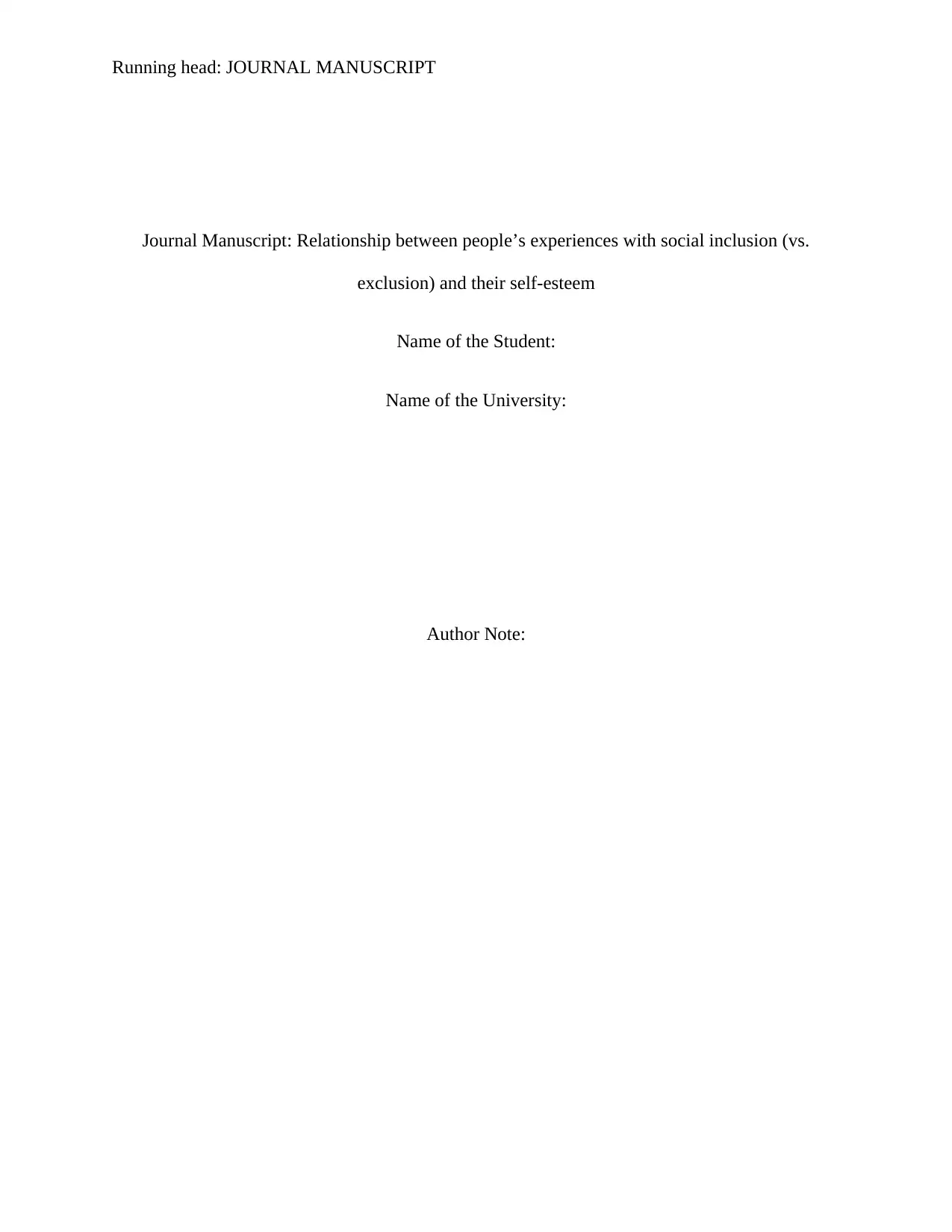
Running head: JOURNAL MANUSCRIPT
Journal Manuscript: Relationship between people’s experiences with social inclusion (vs.
exclusion) and their self-esteem
Name of the Student:
Name of the University:
Author Note:
Journal Manuscript: Relationship between people’s experiences with social inclusion (vs.
exclusion) and their self-esteem
Name of the Student:
Name of the University:
Author Note:
Paraphrase This Document
Need a fresh take? Get an instant paraphrase of this document with our AI Paraphraser
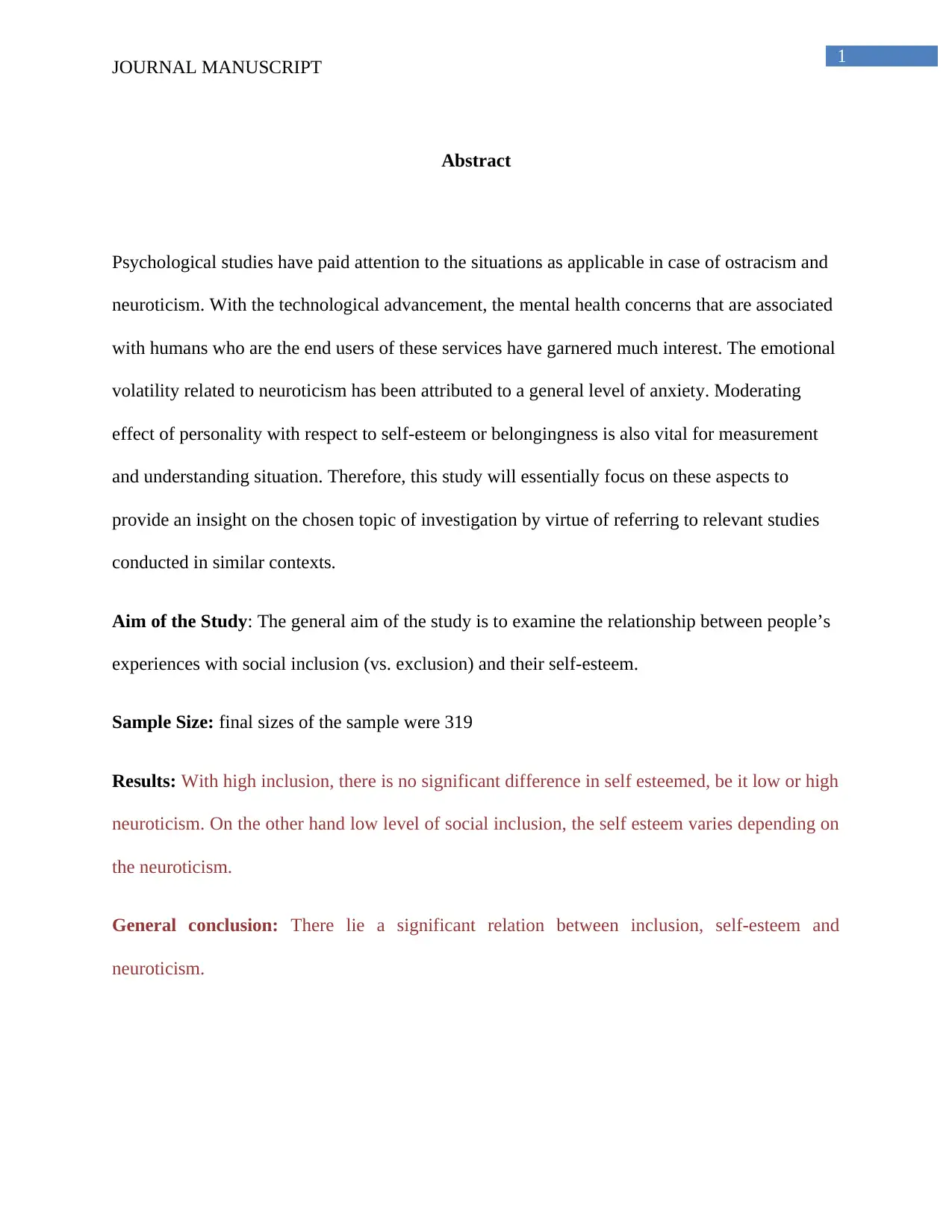
1
JOURNAL MANUSCRIPT
Abstract
Psychological studies have paid attention to the situations as applicable in case of ostracism and
neuroticism. With the technological advancement, the mental health concerns that are associated
with humans who are the end users of these services have garnered much interest. The emotional
volatility related to neuroticism has been attributed to a general level of anxiety. Moderating
effect of personality with respect to self-esteem or belongingness is also vital for measurement
and understanding situation. Therefore, this study will essentially focus on these aspects to
provide an insight on the chosen topic of investigation by virtue of referring to relevant studies
conducted in similar contexts.
Aim of the Study: The general aim of the study is to examine the relationship between people’s
experiences with social inclusion (vs. exclusion) and their self-esteem.
Sample Size: final sizes of the sample were 319
Results: With high inclusion, there is no significant difference in self esteemed, be it low or high
neuroticism. On the other hand low level of social inclusion, the self esteem varies depending on
the neuroticism.
General conclusion: There lie a significant relation between inclusion, self-esteem and
neuroticism.
JOURNAL MANUSCRIPT
Abstract
Psychological studies have paid attention to the situations as applicable in case of ostracism and
neuroticism. With the technological advancement, the mental health concerns that are associated
with humans who are the end users of these services have garnered much interest. The emotional
volatility related to neuroticism has been attributed to a general level of anxiety. Moderating
effect of personality with respect to self-esteem or belongingness is also vital for measurement
and understanding situation. Therefore, this study will essentially focus on these aspects to
provide an insight on the chosen topic of investigation by virtue of referring to relevant studies
conducted in similar contexts.
Aim of the Study: The general aim of the study is to examine the relationship between people’s
experiences with social inclusion (vs. exclusion) and their self-esteem.
Sample Size: final sizes of the sample were 319
Results: With high inclusion, there is no significant difference in self esteemed, be it low or high
neuroticism. On the other hand low level of social inclusion, the self esteem varies depending on
the neuroticism.
General conclusion: There lie a significant relation between inclusion, self-esteem and
neuroticism.
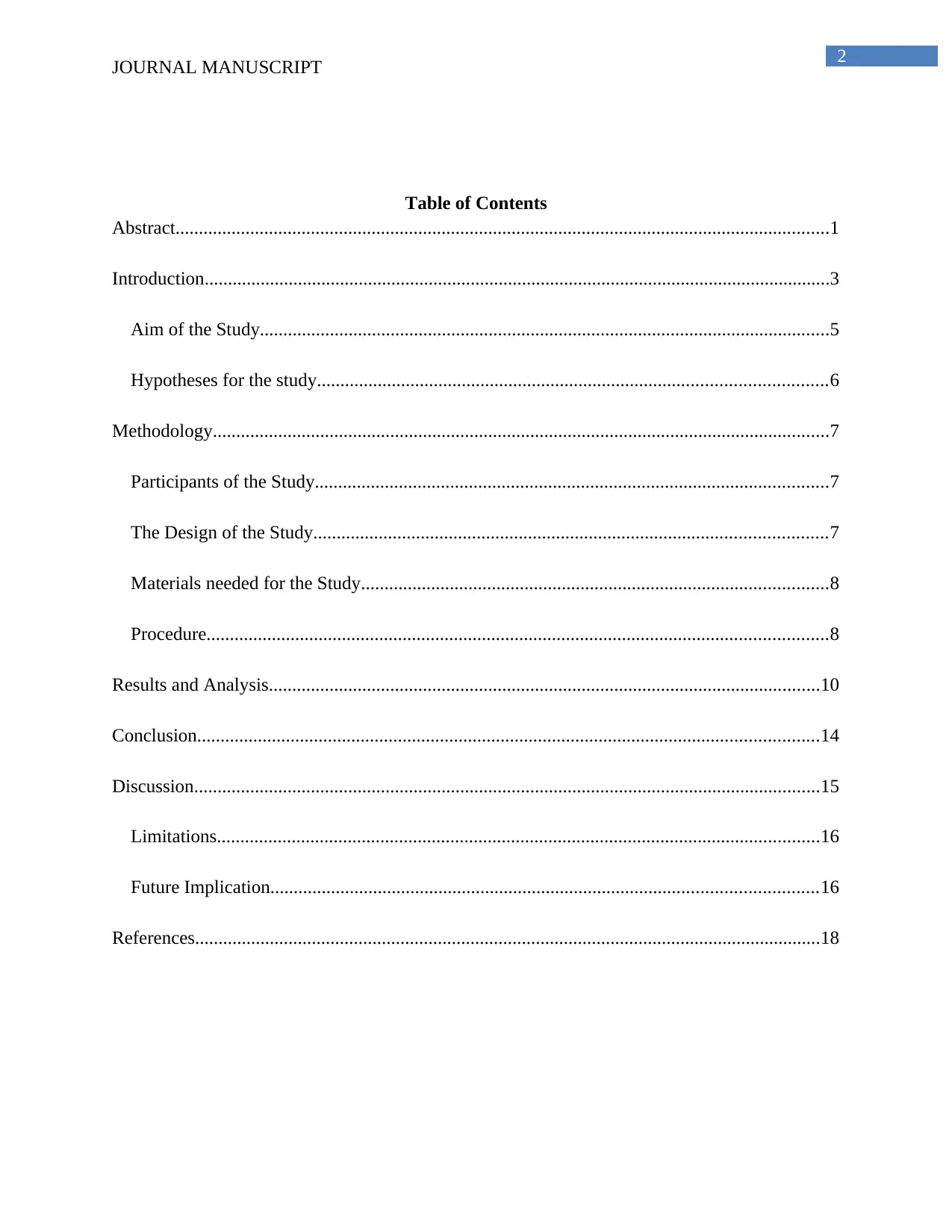
2
JOURNAL MANUSCRIPT
Table of Contents
Abstract............................................................................................................................................1
Introduction......................................................................................................................................3
Aim of the Study..........................................................................................................................5
Hypotheses for the study.............................................................................................................6
Methodology....................................................................................................................................7
Participants of the Study..............................................................................................................7
The Design of the Study..............................................................................................................7
Materials needed for the Study....................................................................................................8
Procedure.....................................................................................................................................8
Results and Analysis......................................................................................................................10
Conclusion.....................................................................................................................................14
Discussion......................................................................................................................................15
Limitations.................................................................................................................................16
Future Implication.....................................................................................................................16
References......................................................................................................................................18
JOURNAL MANUSCRIPT
Table of Contents
Abstract............................................................................................................................................1
Introduction......................................................................................................................................3
Aim of the Study..........................................................................................................................5
Hypotheses for the study.............................................................................................................6
Methodology....................................................................................................................................7
Participants of the Study..............................................................................................................7
The Design of the Study..............................................................................................................7
Materials needed for the Study....................................................................................................8
Procedure.....................................................................................................................................8
Results and Analysis......................................................................................................................10
Conclusion.....................................................................................................................................14
Discussion......................................................................................................................................15
Limitations.................................................................................................................................16
Future Implication.....................................................................................................................16
References......................................................................................................................................18
⊘ This is a preview!⊘
Do you want full access?
Subscribe today to unlock all pages.

Trusted by 1+ million students worldwide

3
JOURNAL MANUSCRIPT
JOURNAL MANUSCRIPT
Paraphrase This Document
Need a fresh take? Get an instant paraphrase of this document with our AI Paraphraser
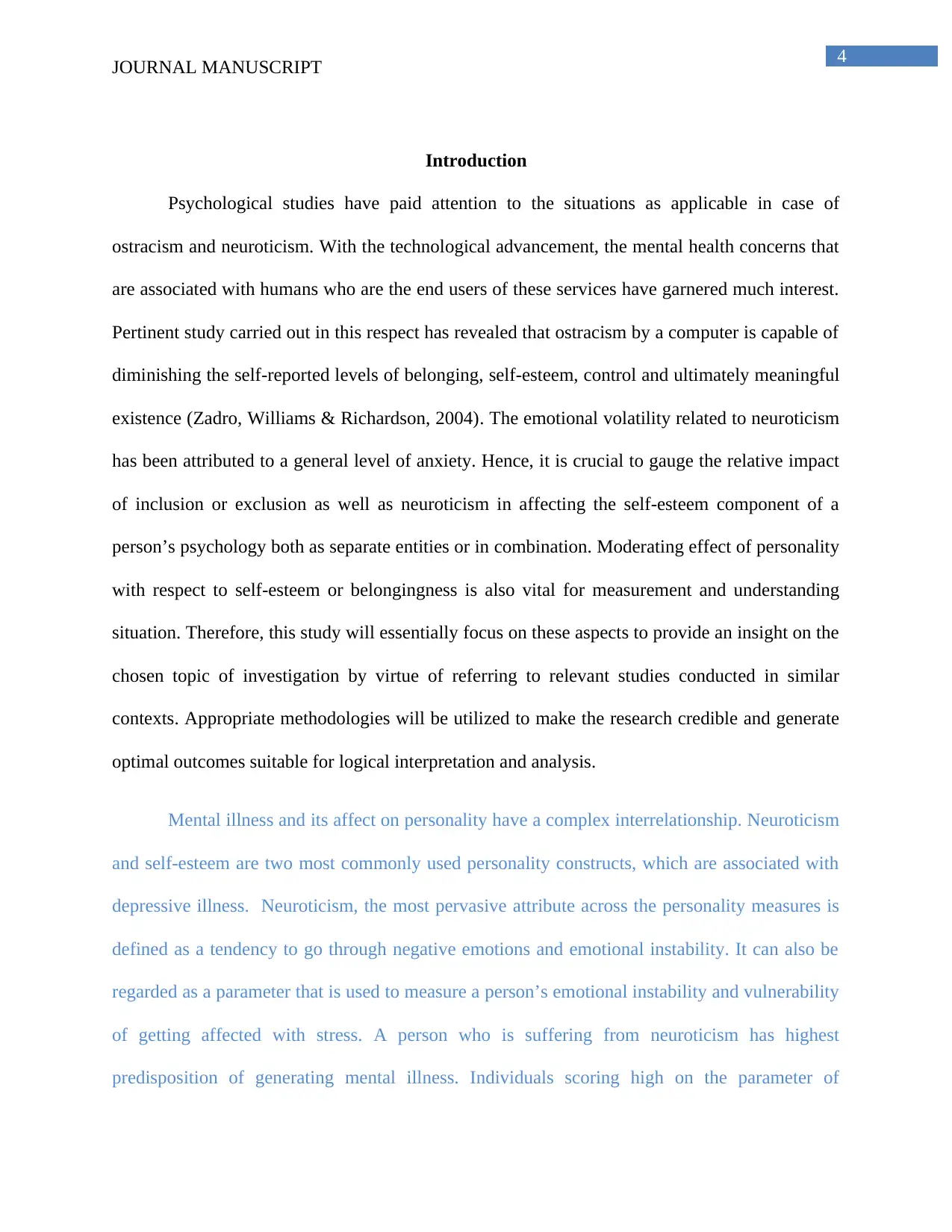
4
JOURNAL MANUSCRIPT
Introduction
Psychological studies have paid attention to the situations as applicable in case of
ostracism and neuroticism. With the technological advancement, the mental health concerns that
are associated with humans who are the end users of these services have garnered much interest.
Pertinent study carried out in this respect has revealed that ostracism by a computer is capable of
diminishing the self-reported levels of belonging, self-esteem, control and ultimately meaningful
existence (Zadro, Williams & Richardson, 2004). The emotional volatility related to neuroticism
has been attributed to a general level of anxiety. Hence, it is crucial to gauge the relative impact
of inclusion or exclusion as well as neuroticism in affecting the self-esteem component of a
person’s psychology both as separate entities or in combination. Moderating effect of personality
with respect to self-esteem or belongingness is also vital for measurement and understanding
situation. Therefore, this study will essentially focus on these aspects to provide an insight on the
chosen topic of investigation by virtue of referring to relevant studies conducted in similar
contexts. Appropriate methodologies will be utilized to make the research credible and generate
optimal outcomes suitable for logical interpretation and analysis.
Mental illness and its affect on personality have a complex interrelationship. Neuroticism
and self-esteem are two most commonly used personality constructs, which are associated with
depressive illness. Neuroticism, the most pervasive attribute across the personality measures is
defined as a tendency to go through negative emotions and emotional instability. It can also be
regarded as a parameter that is used to measure a person’s emotional instability and vulnerability
of getting affected with stress. A person who is suffering from neuroticism has highest
predisposition of generating mental illness. Individuals scoring high on the parameter of
JOURNAL MANUSCRIPT
Introduction
Psychological studies have paid attention to the situations as applicable in case of
ostracism and neuroticism. With the technological advancement, the mental health concerns that
are associated with humans who are the end users of these services have garnered much interest.
Pertinent study carried out in this respect has revealed that ostracism by a computer is capable of
diminishing the self-reported levels of belonging, self-esteem, control and ultimately meaningful
existence (Zadro, Williams & Richardson, 2004). The emotional volatility related to neuroticism
has been attributed to a general level of anxiety. Hence, it is crucial to gauge the relative impact
of inclusion or exclusion as well as neuroticism in affecting the self-esteem component of a
person’s psychology both as separate entities or in combination. Moderating effect of personality
with respect to self-esteem or belongingness is also vital for measurement and understanding
situation. Therefore, this study will essentially focus on these aspects to provide an insight on the
chosen topic of investigation by virtue of referring to relevant studies conducted in similar
contexts. Appropriate methodologies will be utilized to make the research credible and generate
optimal outcomes suitable for logical interpretation and analysis.
Mental illness and its affect on personality have a complex interrelationship. Neuroticism
and self-esteem are two most commonly used personality constructs, which are associated with
depressive illness. Neuroticism, the most pervasive attribute across the personality measures is
defined as a tendency to go through negative emotions and emotional instability. It can also be
regarded as a parameter that is used to measure a person’s emotional instability and vulnerability
of getting affected with stress. A person who is suffering from neuroticism has highest
predisposition of generating mental illness. Individuals scoring high on the parameter of
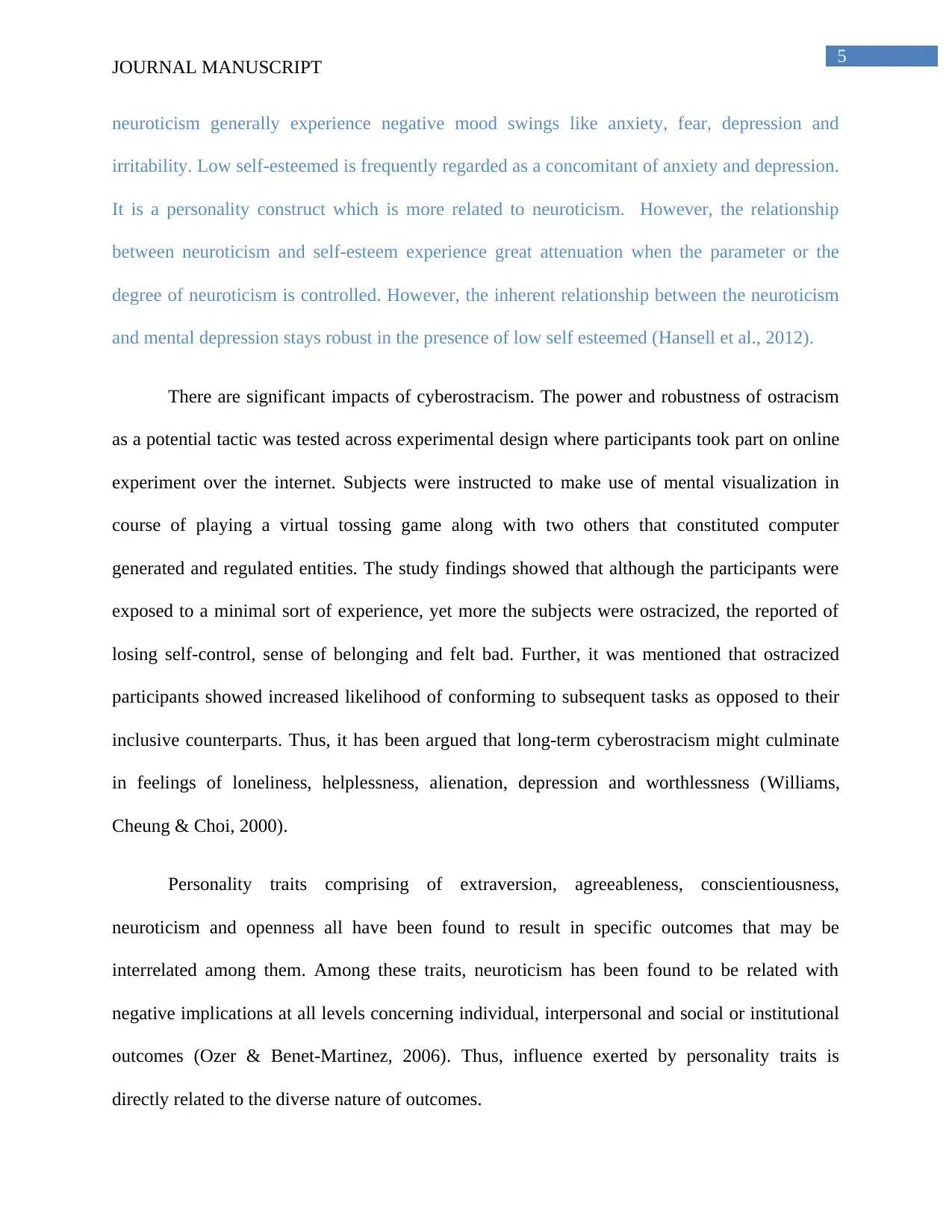
5
JOURNAL MANUSCRIPT
neuroticism generally experience negative mood swings like anxiety, fear, depression and
irritability. Low self-esteemed is frequently regarded as a concomitant of anxiety and depression.
It is a personality construct which is more related to neuroticism. However, the relationship
between neuroticism and self-esteem experience great attenuation when the parameter or the
degree of neuroticism is controlled. However, the inherent relationship between the neuroticism
and mental depression stays robust in the presence of low self esteemed (Hansell et al., 2012).
There are significant impacts of cyberostracism. The power and robustness of ostracism
as a potential tactic was tested across experimental design where participants took part on online
experiment over the internet. Subjects were instructed to make use of mental visualization in
course of playing a virtual tossing game along with two others that constituted computer
generated and regulated entities. The study findings showed that although the participants were
exposed to a minimal sort of experience, yet more the subjects were ostracized, the reported of
losing self-control, sense of belonging and felt bad. Further, it was mentioned that ostracized
participants showed increased likelihood of conforming to subsequent tasks as opposed to their
inclusive counterparts. Thus, it has been argued that long-term cyberostracism might culminate
in feelings of loneliness, helplessness, alienation, depression and worthlessness (Williams,
Cheung & Choi, 2000).
Personality traits comprising of extraversion, agreeableness, conscientiousness,
neuroticism and openness all have been found to result in specific outcomes that may be
interrelated among them. Among these traits, neuroticism has been found to be related with
negative implications at all levels concerning individual, interpersonal and social or institutional
outcomes (Ozer & Benet-Martinez, 2006). Thus, influence exerted by personality traits is
directly related to the diverse nature of outcomes.
JOURNAL MANUSCRIPT
neuroticism generally experience negative mood swings like anxiety, fear, depression and
irritability. Low self-esteemed is frequently regarded as a concomitant of anxiety and depression.
It is a personality construct which is more related to neuroticism. However, the relationship
between neuroticism and self-esteem experience great attenuation when the parameter or the
degree of neuroticism is controlled. However, the inherent relationship between the neuroticism
and mental depression stays robust in the presence of low self esteemed (Hansell et al., 2012).
There are significant impacts of cyberostracism. The power and robustness of ostracism
as a potential tactic was tested across experimental design where participants took part on online
experiment over the internet. Subjects were instructed to make use of mental visualization in
course of playing a virtual tossing game along with two others that constituted computer
generated and regulated entities. The study findings showed that although the participants were
exposed to a minimal sort of experience, yet more the subjects were ostracized, the reported of
losing self-control, sense of belonging and felt bad. Further, it was mentioned that ostracized
participants showed increased likelihood of conforming to subsequent tasks as opposed to their
inclusive counterparts. Thus, it has been argued that long-term cyberostracism might culminate
in feelings of loneliness, helplessness, alienation, depression and worthlessness (Williams,
Cheung & Choi, 2000).
Personality traits comprising of extraversion, agreeableness, conscientiousness,
neuroticism and openness all have been found to result in specific outcomes that may be
interrelated among them. Among these traits, neuroticism has been found to be related with
negative implications at all levels concerning individual, interpersonal and social or institutional
outcomes (Ozer & Benet-Martinez, 2006). Thus, influence exerted by personality traits is
directly related to the diverse nature of outcomes.
⊘ This is a preview!⊘
Do you want full access?
Subscribe today to unlock all pages.

Trusted by 1+ million students worldwide
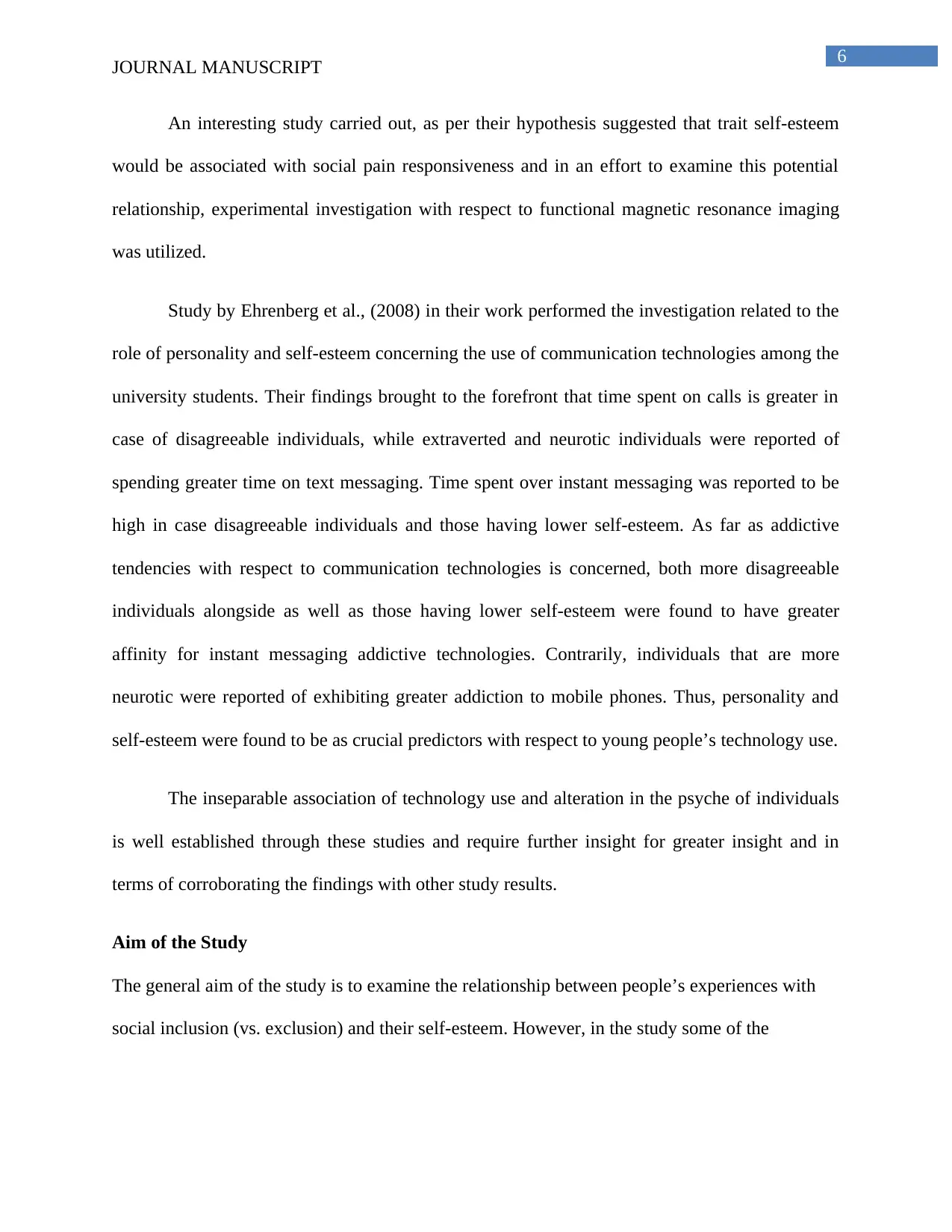
6
JOURNAL MANUSCRIPT
An interesting study carried out, as per their hypothesis suggested that trait self-esteem
would be associated with social pain responsiveness and in an effort to examine this potential
relationship, experimental investigation with respect to functional magnetic resonance imaging
was utilized.
Study by Ehrenberg et al., (2008) in their work performed the investigation related to the
role of personality and self-esteem concerning the use of communication technologies among the
university students. Their findings brought to the forefront that time spent on calls is greater in
case of disagreeable individuals, while extraverted and neurotic individuals were reported of
spending greater time on text messaging. Time spent over instant messaging was reported to be
high in case disagreeable individuals and those having lower self-esteem. As far as addictive
tendencies with respect to communication technologies is concerned, both more disagreeable
individuals alongside as well as those having lower self-esteem were found to have greater
affinity for instant messaging addictive technologies. Contrarily, individuals that are more
neurotic were reported of exhibiting greater addiction to mobile phones. Thus, personality and
self-esteem were found to be as crucial predictors with respect to young people’s technology use.
The inseparable association of technology use and alteration in the psyche of individuals
is well established through these studies and require further insight for greater insight and in
terms of corroborating the findings with other study results.
Aim of the Study
The general aim of the study is to examine the relationship between people’s experiences with
social inclusion (vs. exclusion) and their self-esteem. However, in the study some of the
JOURNAL MANUSCRIPT
An interesting study carried out, as per their hypothesis suggested that trait self-esteem
would be associated with social pain responsiveness and in an effort to examine this potential
relationship, experimental investigation with respect to functional magnetic resonance imaging
was utilized.
Study by Ehrenberg et al., (2008) in their work performed the investigation related to the
role of personality and self-esteem concerning the use of communication technologies among the
university students. Their findings brought to the forefront that time spent on calls is greater in
case of disagreeable individuals, while extraverted and neurotic individuals were reported of
spending greater time on text messaging. Time spent over instant messaging was reported to be
high in case disagreeable individuals and those having lower self-esteem. As far as addictive
tendencies with respect to communication technologies is concerned, both more disagreeable
individuals alongside as well as those having lower self-esteem were found to have greater
affinity for instant messaging addictive technologies. Contrarily, individuals that are more
neurotic were reported of exhibiting greater addiction to mobile phones. Thus, personality and
self-esteem were found to be as crucial predictors with respect to young people’s technology use.
The inseparable association of technology use and alteration in the psyche of individuals
is well established through these studies and require further insight for greater insight and in
terms of corroborating the findings with other study results.
Aim of the Study
The general aim of the study is to examine the relationship between people’s experiences with
social inclusion (vs. exclusion) and their self-esteem. However, in the study some of the
Paraphrase This Document
Need a fresh take? Get an instant paraphrase of this document with our AI Paraphraser
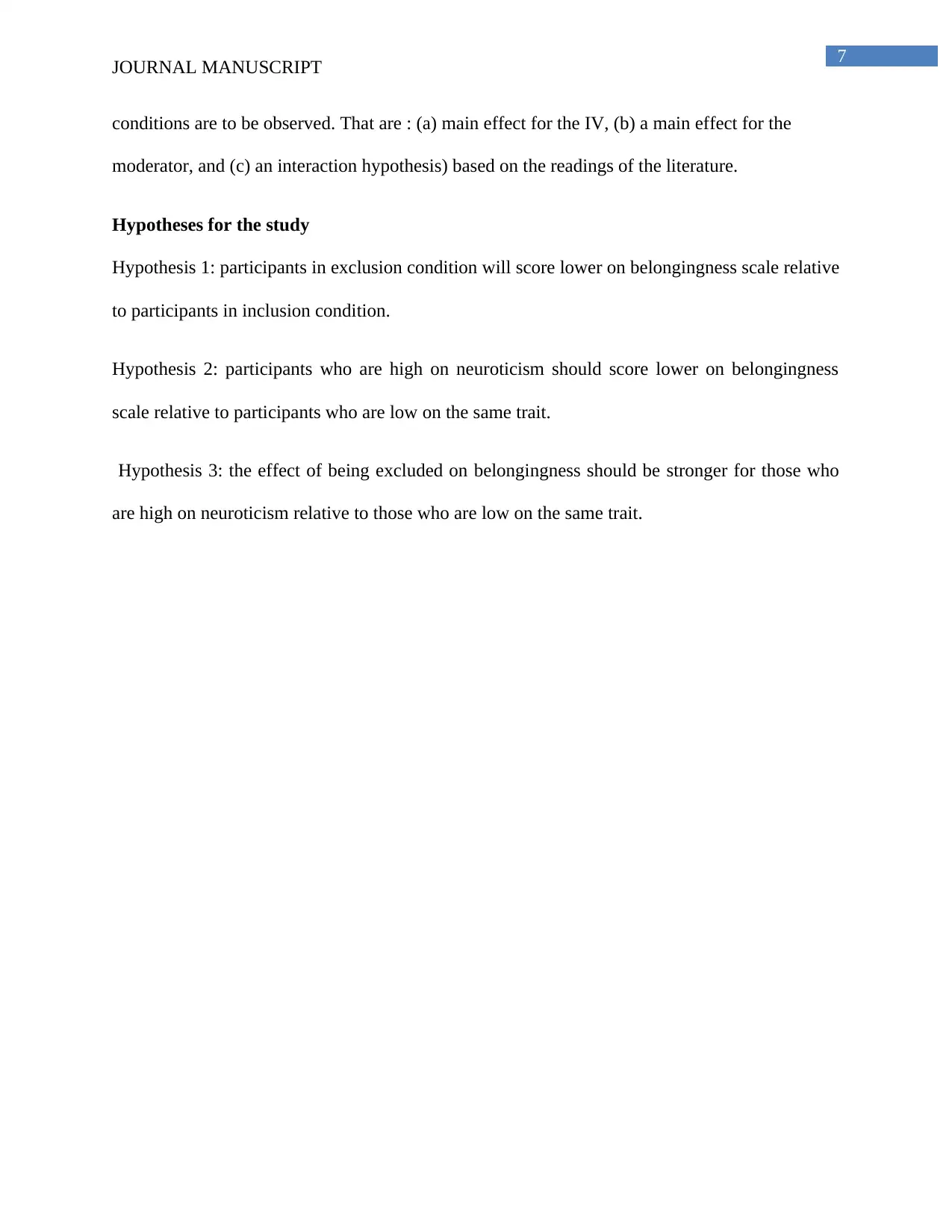
7
JOURNAL MANUSCRIPT
conditions are to be observed. That are : (a) main effect for the IV, (b) a main effect for the
moderator, and (c) an interaction hypothesis) based on the readings of the literature.
Hypotheses for the study
Hypothesis 1: participants in exclusion condition will score lower on belongingness scale relative
to participants in inclusion condition.
Hypothesis 2: participants who are high on neuroticism should score lower on belongingness
scale relative to participants who are low on the same trait.
Hypothesis 3: the effect of being excluded on belongingness should be stronger for those who
are high on neuroticism relative to those who are low on the same trait.
JOURNAL MANUSCRIPT
conditions are to be observed. That are : (a) main effect for the IV, (b) a main effect for the
moderator, and (c) an interaction hypothesis) based on the readings of the literature.
Hypotheses for the study
Hypothesis 1: participants in exclusion condition will score lower on belongingness scale relative
to participants in inclusion condition.
Hypothesis 2: participants who are high on neuroticism should score lower on belongingness
scale relative to participants who are low on the same trait.
Hypothesis 3: the effect of being excluded on belongingness should be stronger for those who
are high on neuroticism relative to those who are low on the same trait.
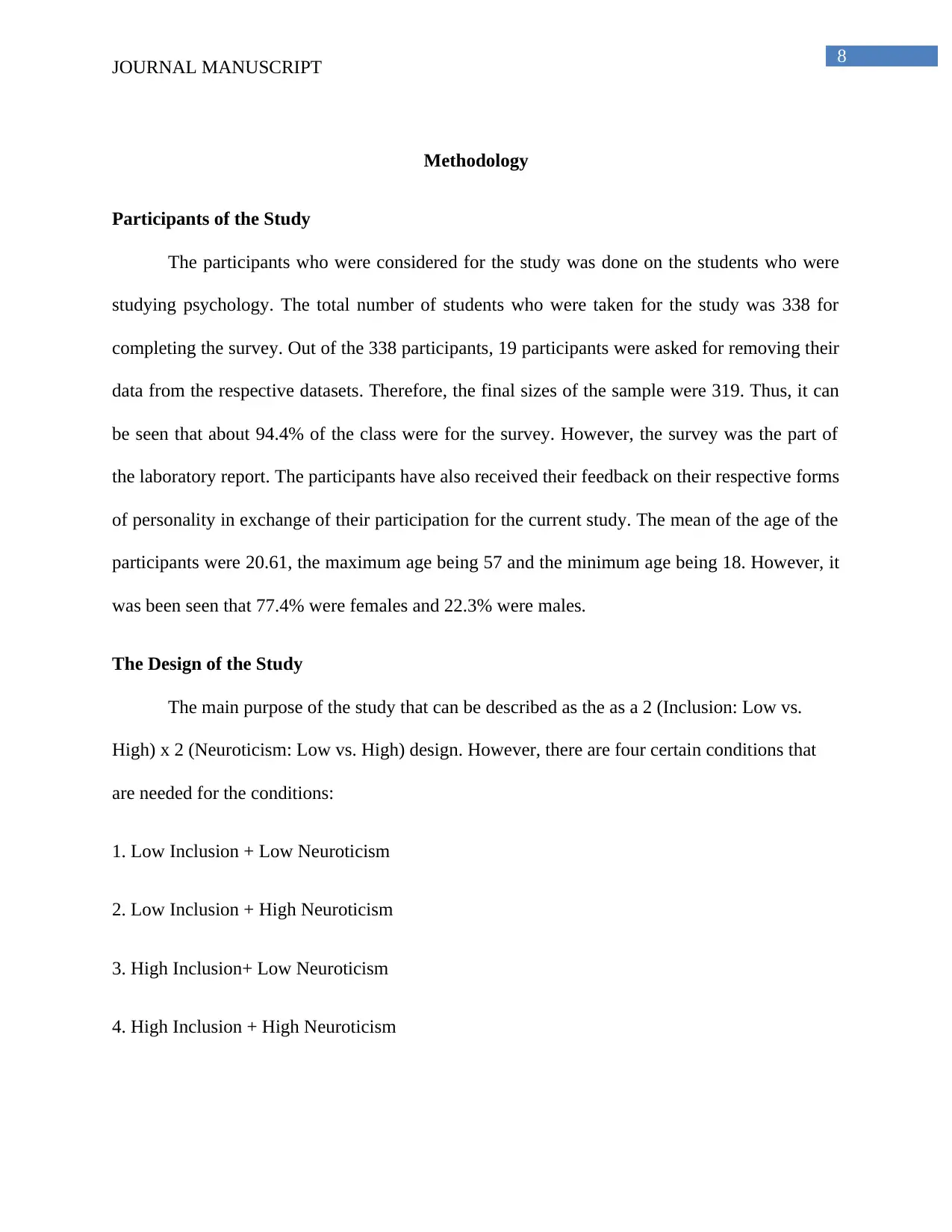
8
JOURNAL MANUSCRIPT
Methodology
Participants of the Study
The participants who were considered for the study was done on the students who were
studying psychology. The total number of students who were taken for the study was 338 for
completing the survey. Out of the 338 participants, 19 participants were asked for removing their
data from the respective datasets. Therefore, the final sizes of the sample were 319. Thus, it can
be seen that about 94.4% of the class were for the survey. However, the survey was the part of
the laboratory report. The participants have also received their feedback on their respective forms
of personality in exchange of their participation for the current study. The mean of the age of the
participants were 20.61, the maximum age being 57 and the minimum age being 18. However, it
was been seen that 77.4% were females and 22.3% were males.
The Design of the Study
The main purpose of the study that can be described as the as a 2 (Inclusion: Low vs.
High) x 2 (Neuroticism: Low vs. High) design. However, there are four certain conditions that
are needed for the conditions:
1. Low Inclusion + Low Neuroticism
2. Low Inclusion + High Neuroticism
3. High Inclusion+ Low Neuroticism
4. High Inclusion + High Neuroticism
JOURNAL MANUSCRIPT
Methodology
Participants of the Study
The participants who were considered for the study was done on the students who were
studying psychology. The total number of students who were taken for the study was 338 for
completing the survey. Out of the 338 participants, 19 participants were asked for removing their
data from the respective datasets. Therefore, the final sizes of the sample were 319. Thus, it can
be seen that about 94.4% of the class were for the survey. However, the survey was the part of
the laboratory report. The participants have also received their feedback on their respective forms
of personality in exchange of their participation for the current study. The mean of the age of the
participants were 20.61, the maximum age being 57 and the minimum age being 18. However, it
was been seen that 77.4% were females and 22.3% were males.
The Design of the Study
The main purpose of the study that can be described as the as a 2 (Inclusion: Low vs.
High) x 2 (Neuroticism: Low vs. High) design. However, there are four certain conditions that
are needed for the conditions:
1. Low Inclusion + Low Neuroticism
2. Low Inclusion + High Neuroticism
3. High Inclusion+ Low Neuroticism
4. High Inclusion + High Neuroticism
⊘ This is a preview!⊘
Do you want full access?
Subscribe today to unlock all pages.

Trusted by 1+ million students worldwide
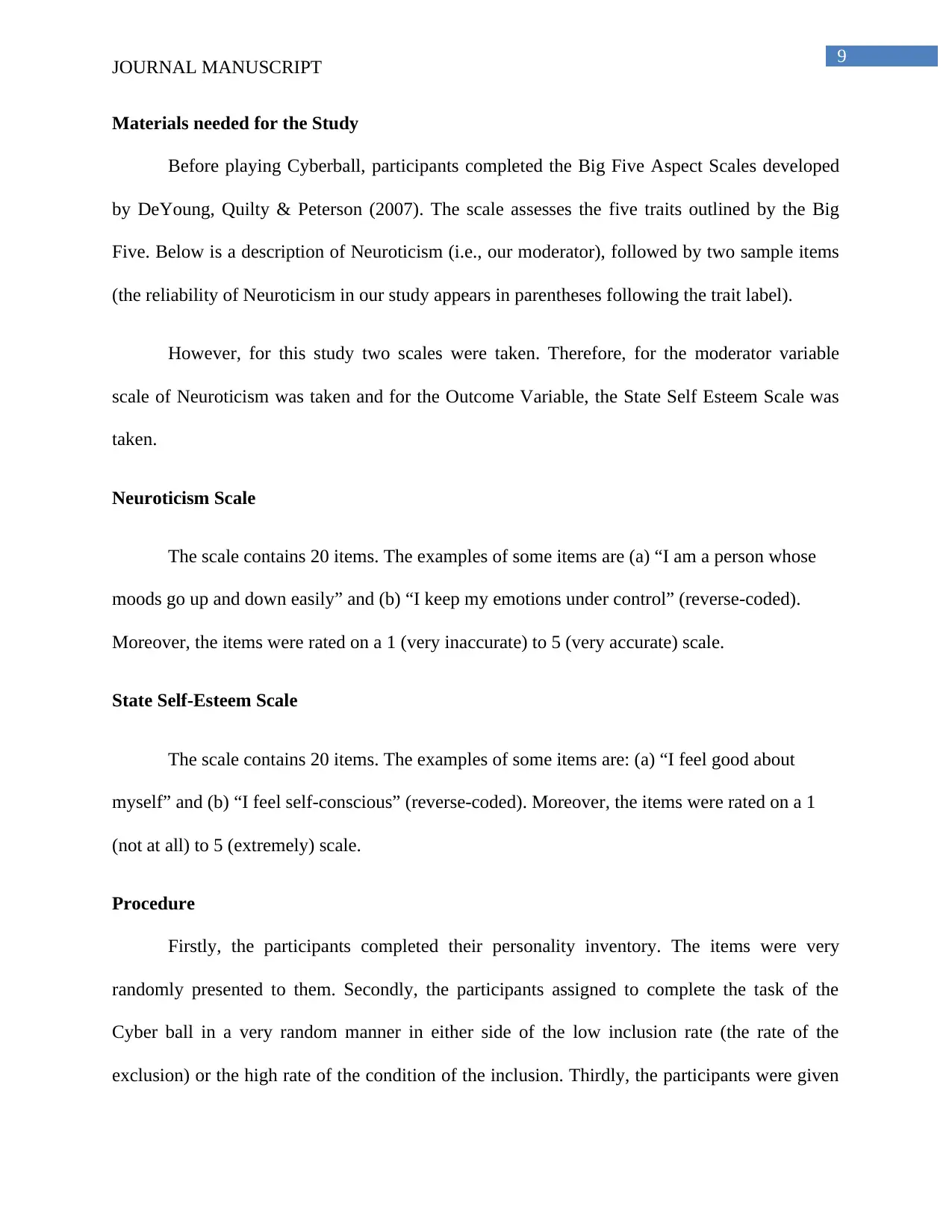
9
JOURNAL MANUSCRIPT
Materials needed for the Study
Before playing Cyberball, participants completed the Big Five Aspect Scales developed
by DeYoung, Quilty & Peterson (2007). The scale assesses the five traits outlined by the Big
Five. Below is a description of Neuroticism (i.e., our moderator), followed by two sample items
(the reliability of Neuroticism in our study appears in parentheses following the trait label).
However, for this study two scales were taken. Therefore, for the moderator variable
scale of Neuroticism was taken and for the Outcome Variable, the State Self Esteem Scale was
taken.
Neuroticism Scale
The scale contains 20 items. The examples of some items are (a) “I am a person whose
moods go up and down easily” and (b) “I keep my emotions under control” (reverse-coded).
Moreover, the items were rated on a 1 (very inaccurate) to 5 (very accurate) scale.
State Self-Esteem Scale
The scale contains 20 items. The examples of some items are: (a) “I feel good about
myself” and (b) “I feel self-conscious” (reverse-coded). Moreover, the items were rated on a 1
(not at all) to 5 (extremely) scale.
Procedure
Firstly, the participants completed their personality inventory. The items were very
randomly presented to them. Secondly, the participants assigned to complete the task of the
Cyber ball in a very random manner in either side of the low inclusion rate (the rate of the
exclusion) or the high rate of the condition of the inclusion. Thirdly, the participants were given
JOURNAL MANUSCRIPT
Materials needed for the Study
Before playing Cyberball, participants completed the Big Five Aspect Scales developed
by DeYoung, Quilty & Peterson (2007). The scale assesses the five traits outlined by the Big
Five. Below is a description of Neuroticism (i.e., our moderator), followed by two sample items
(the reliability of Neuroticism in our study appears in parentheses following the trait label).
However, for this study two scales were taken. Therefore, for the moderator variable
scale of Neuroticism was taken and for the Outcome Variable, the State Self Esteem Scale was
taken.
Neuroticism Scale
The scale contains 20 items. The examples of some items are (a) “I am a person whose
moods go up and down easily” and (b) “I keep my emotions under control” (reverse-coded).
Moreover, the items were rated on a 1 (very inaccurate) to 5 (very accurate) scale.
State Self-Esteem Scale
The scale contains 20 items. The examples of some items are: (a) “I feel good about
myself” and (b) “I feel self-conscious” (reverse-coded). Moreover, the items were rated on a 1
(not at all) to 5 (extremely) scale.
Procedure
Firstly, the participants completed their personality inventory. The items were very
randomly presented to them. Secondly, the participants assigned to complete the task of the
Cyber ball in a very random manner in either side of the low inclusion rate (the rate of the
exclusion) or the high rate of the condition of the inclusion. Thirdly, the participants were given
Paraphrase This Document
Need a fresh take? Get an instant paraphrase of this document with our AI Paraphraser

10
JOURNAL MANUSCRIPT
the set of the scales that have included the variable that are dependent. Lastly, the participants
after completing their demographic questionnaire, they were being very carefully debriefed by
the experimenter. Therefore, the whole study was been conducted for approximately 40 minutes.
JOURNAL MANUSCRIPT
the set of the scales that have included the variable that are dependent. Lastly, the participants
after completing their demographic questionnaire, they were being very carefully debriefed by
the experimenter. Therefore, the whole study was been conducted for approximately 40 minutes.
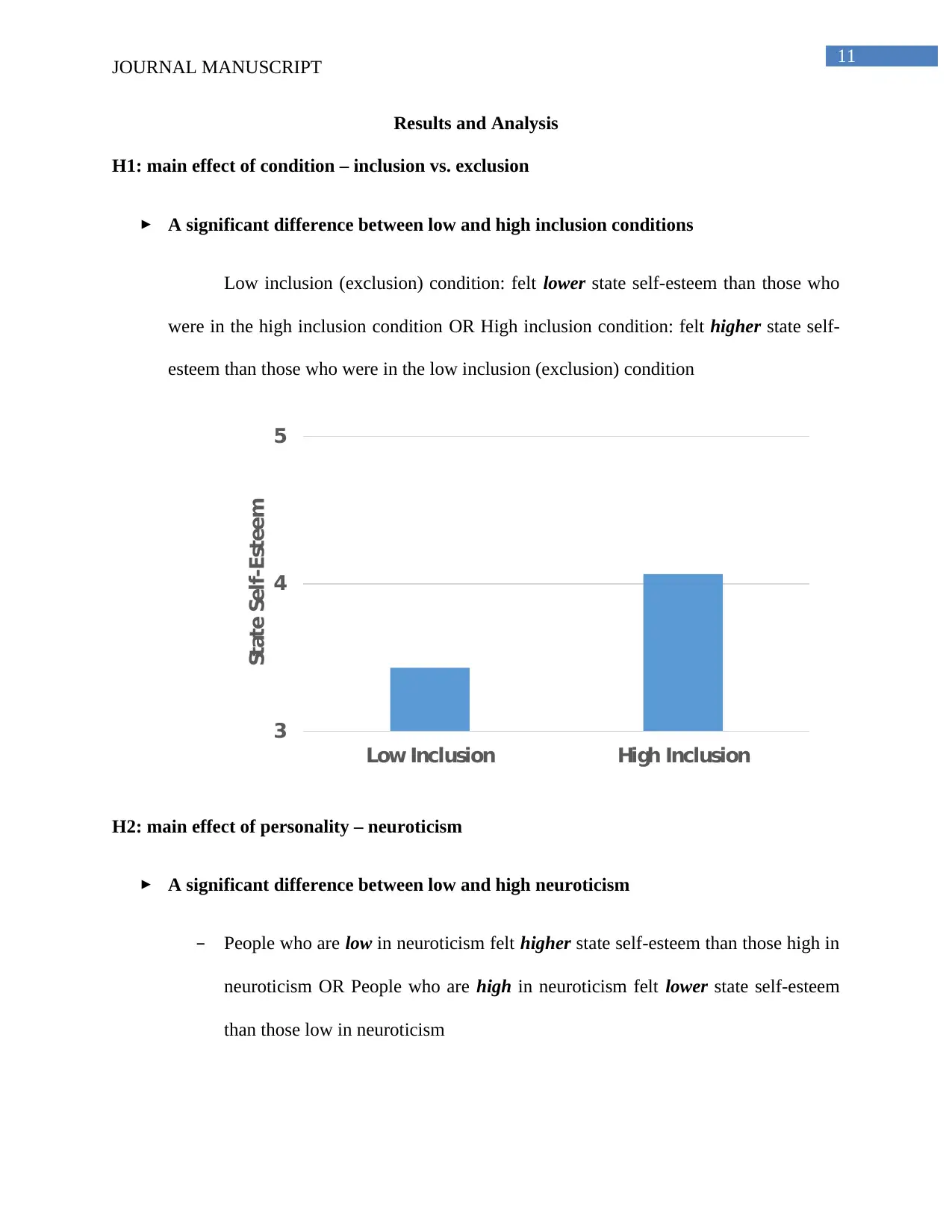
11
JOURNAL MANUSCRIPT
Results and Analysis
H1: main effect of condition – inclusion vs. exclusion
A significant difference between low and high inclusion conditions
Low inclusion (exclusion) condition: felt lower state self-esteem than those who
were in the high inclusion condition OR High inclusion condition: felt higher state self-
esteem than those who were in the low inclusion (exclusion) condition
3
4
5
Low Inclusion High Inclusion
State Self-Esteem
H2: main effect of personality – neuroticism
A significant difference between low and high neuroticism
– People who are low in neuroticism felt higher state self-esteem than those high in
neuroticism OR People who are high in neuroticism felt lower state self-esteem
than those low in neuroticism
JOURNAL MANUSCRIPT
Results and Analysis
H1: main effect of condition – inclusion vs. exclusion
A significant difference between low and high inclusion conditions
Low inclusion (exclusion) condition: felt lower state self-esteem than those who
were in the high inclusion condition OR High inclusion condition: felt higher state self-
esteem than those who were in the low inclusion (exclusion) condition
3
4
5
Low Inclusion High Inclusion
State Self-Esteem
H2: main effect of personality – neuroticism
A significant difference between low and high neuroticism
– People who are low in neuroticism felt higher state self-esteem than those high in
neuroticism OR People who are high in neuroticism felt lower state self-esteem
than those low in neuroticism
⊘ This is a preview!⊘
Do you want full access?
Subscribe today to unlock all pages.

Trusted by 1+ million students worldwide
1 out of 21
Your All-in-One AI-Powered Toolkit for Academic Success.
+13062052269
info@desklib.com
Available 24*7 on WhatsApp / Email
![[object Object]](/_next/static/media/star-bottom.7253800d.svg)
Unlock your academic potential
Copyright © 2020–2025 A2Z Services. All Rights Reserved. Developed and managed by ZUCOL.
